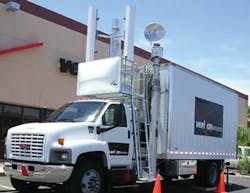In this day and age, cell phones are everywhere, which makes them a double-edged sword: they’re useful when they work, but people are severely inconvenienced when they don’t. This can be especially true for wildland firefighters who depend on cell phones, laptops and repeater stations to get updates on the latest fire information. Needless to say, wildland areas don’t usually boast the best cell phone reception around. But Verizon Wireless has some solutions to this problem that sound more like a barnyard than cutting-edge telecommunications!
COLTs, COWs, RATs and GOATs
Sensing the need for reliable telecommunications at remote locations, Verizon Wireless (VZW) has come up with technology to meet this challenge – although with some funny names. For cell phone service, they have devised two useful implements: COLTs (Cell on Light Truck) and COWs (Cell on Wheels), basically portable cell towers that can be transported easily to any place with road access and setup in a matter of minutes to provide reliable cell service.
As the name implies, a COLT is a cell tower system that has been incorporated into a light truck body, looking a bit like the news vans you often see transmitting breaking news to satellites. COWs are a little simpler in design, being basically a two-wheel trailer with an expandable cell tower attached.
For those who rely on repeaters, VZW has you covered. They can deploy RAT (Repeater and Trailer) units which are similar to the COW, but instead of a full-blown cell tower, this trailer carries a repeater for radio traffic. Needless to say, this can be very useful for areas not well served by existing repeater stations, or for augmenting the existing repeaters when there is a need to support more radio traffic at an incident.
GOATs (Generator on a Trailer) are the reserve power sources that can power existing cell sites that have lost power, as well as other VZW telecommunications hardware in the field.
Case Studies
To find out more about these unique systems, Ken Muche, a VZW public relations spokesman in Southern California, gave us some actual cases in which this equipment made a significant difference and, in some cases, saved lives.
“One example I’ve heard was from the 2007 San Diego fires where there was a report from one of the rural areas that a man and his family were trapped by the fire by the gates into his ranch – he couldn’t get out,” Muche recalled. “Because of a COLT or COW that we had deployed a few days before, they were able to reach one of the police chiefs and one of the fire chiefs who arrived at the scene, pulled an axe out of their vehicle, went to the chain on the gate, hacked it down, with these intense flames just 10-15 yards behind the family’s car, and together these two men saved this family.”
Their equipment also had an impact on the Station Fire, the largest wildfire in Los Angeles County’s history. “In the Station Fire, we provided CAL FIRE [the California Department of Forestry and Fire Protection] with mobile wireless hotspots that are about the size of your hand and only weigh a couple of ounces,” said Muche. “You can wirelessly connect up to five 3G WiFi devices to these hotspots, and our 4G system, which is 10 times faster, can hold up to eight 4G WiFi connections at once. So what the CAL FIRE firefighters did on the Station Fire was to go out with five trucks, the WiFi hotspot being in the middle truck, and they would setup their laptops and get screen shots of maps, shots of the fire, and wind reports, all in real time.”
Muche added, “What’s cool about the 4G hotspot is that you can get 4G speeds with a 3G device, which is incredible! The real-world implications for this system are dramatic, and it’s critical in these situations.”
First-Responder Mentality
“Our credo at Verizon Wireless is that we run to a crisis, we don’t run away from it,” Muche explained. A bit like the firefighter mentality in which they run into burning buildings/wildlands when everybody else is running out!
Like First Responders, VZW forward-deploys their equipment. “We have dozens and dozens of these stationed throughout [our service areas] and in addition we have GOATs,” Muche affirmed.
Going the Extra Mile
VZW believes in making sure everything will work when seconds count, too. “Our equipment has a lot of redundancy, backup power, including on cell towers, where we have batteries that will last for 6-8 hours and generators that will run on gas for another eight hours, and when they run out, we can bring in a GOAT,” said Muche. “This is the case for COLTs and COWs as well.”
And they support base camp operations. “We also provide charging stations at the Red Cross stations to charge cell phone batteries, hook up laptops with wireless connectivity, and for those who don’t have a cell phone because they had to flee, we’ll loan them cell phones to make as many free calls as they need to make,” Muche pointed out. “We also take the laptops and netbooks, along with the charging centers, out to the command centers for firefighters, sheriffs and other First Responders because they’re often not near commercial centers [with cell towers], and they may not have their chargers with them, so we bring patch cords that they can use, so there’s a lot that we do at these crises.”
Muche says that VZW not only forward deploys cell phones for emergency use by agencies like the U.S. Forest Service and CAL FIRE, they help them get up and running in any kind of a crisis right away. “We also have an emergency hotline that we share with First Responders,” he reported. “We deploy hundreds of cell phones, wireless modems, and laptops for these folks.”
Besides that, VZW does due diligence around their existing cell sites so that communications are not interrupted when wildfires come calling at their facilities. “Another thing we do that can make the difference between a cell tower working or melting down in a wildfire is regular weed and brush abatement,” added Muche.
MIKE ARCHER is an author, wildfire consultant, systems engineer, and public speaker who has been interviewed by CBS News, KABC-TV, USA Today, and the Associated Press on wildfire topics, and has been part of a delegation testifying before government bodies (including Congress and the California Senate) on fire-related issues. He runs the Wildfire News of the Day blog and Firebomber Publications.
About the Author

Mike Archer
Firehouse.com Contributor
MIKE ARCHER is an author, wildfire consultant, systems engineer, and public speaker who has been interviewed by CBS News, KABC-TV, USA Today, and the Associated Press on wildfire topics, and has been part of a delegation testifying before government bodies (including Congress and the California Senate) on fire-related issues. He runs the Wildfire News of the Day blog and Firebomber Publications.
